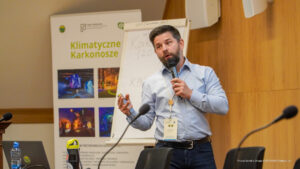TransParcNet 2025, Sandra Grego
Date: June 9–12, 2025
Location: Sobieszów, Poland
Theme: Managing Overtourism – Balancing Conservation and Visitor Pressure in Transboundary Areas

A Cross-Border Call for Action on Overtourism
From the heart of the Krkonoše Mountains, TransParcNet 2025 brought together conservation leaders, researchers, and policymakers from across Europe. This milestone gathering—celebrating 22 years of the EUROPARC Transboundary Programme—was laser-focused on one urgent issue: overtourism in protected natural areas.
Hosted by the Krkonoše Transboundary Area (Poland–Czechia), the event united voices from over 20 countries to explore solutions that protect both nature and local communities in shared landscapes.
Key Takeaways and Insights
- A New Framework for Recreation Planning
Prof. Simon Bell introduced a visionary framework based on Landscape Character Assessment (LCA)—a tool that respects the “spirit of place” and empowers cross-border parks to design visitor strategies rooted in culture, ecology, and sensitivity. His message was clear: more trails do not mean less pressure.
- Data-Driven Overtourism Management
Dr. Mateusz Rogowski presented eye-opening statistics: over 2.3 million visitors annually flood Karkonosze National Park—over 39,000 per km²! His Method of Overtourism Optimisation (MOO), including timed entries and route diversification, showed promising success in distributing visitors without excluding them.
- Mapping Impact with Technology
The RekreENVI project, led by Dr. Dušan Romportl and Dr. Martin Erlebach, used apps like STRAVA and AI tools to monitor tourism’s effects on biodiversity. Their zonation maps now guide decisions in sensitive habitats, especially for endangered species like the Black Grouse.
- Smart Monitoring in Action
Karkonosze National Park’s team showcased a hybrid approach combining trail counters, social media, and AI image recognition to detect “hot zones” where tourism clashes with wildlife. These methods are now setting a new standard for protected area monitoring.
Stronger Together: EU & Global Partners Weigh In
From the IUCN WCPA to the European Commission and Mission Opérationnelle Transfrontalière (MOT), institutional support for transboundary cooperation is stronger than ever. Presenters highlighted funding tools, digital dashboards, and youth engagement strategies that align directly with TransParcNet’s goals.
Open Mic, Open Minds: Real Stories from the Field

Voices from across Europe—from Arctic Sámi lands to Central European wetlands—painted a diverse picture of overtourism
- Binntal Veglia Devero uses buffer zones as intentional “visitor magnets.”
-
Pasvik-Inari protects Indigenous values alongside fragile ecosystems.
-
Saxon-Bohemian Switzerland faces seasonal overcrowding but combats it with transit solutions and law enforcement.
-
Duna Drava and Neusiedler See manage sensitive riverbanks and wetland trails with strict zoning and international coordination.
Field Trips: On the Ground, In the Wild
TransParcNet attendees hiked through Śnieżka, Szrenica, and the Karkonoska Pass, experiencing firsthand the challenges of high-altitude conservation. Each excursion sparked dynamic discussions on sustainable trails, private sector pressures, and visitor flow control.
Newcomers to TransParcNet

This year welcomed promising transboundary partnerships:
-
Sar Mountain National Park (North Macedonia <> Kosovo)
-
Duna-Dráva National Park (Hungary <> Croatia)
-
West Pomeranian Voivodeship (Poland <> Germany’s Unteres Odertal)
These areas were invited to the annual meeting to bring fresh energy and commitment to cross-border conservation. Bother TrasParcNet and EUROPARC teams are ready to assist all three partners on their journeys toward Tansboundary Programme certification.
Final Word: Cooperation Is Conservation
As global challenges grow, TransParcNet 2025 proved that working across borders is not only possible—it’s essential. From overtourism management to cultural respect and ecological resilience, the network stands united in its mission – Nature — and people — flourish beyond borders. We thank all participants, presenters, and local hosts for a deeply inspiring and practically impactful meeting.
TransParcNet 2025 Photo Album:
TransParcNet 2025 Programme:
TransParcNet 2025 Report:
- Coming this week!
Exclusive: TransParcnet 2025 Poem, written by Simon Bell:
TransParcNet 2025 Presentations:
- Simon Bell Estonian University of Life Sciences
- Mateusz Rogowski Adam M. UNI
- Martin Dusan and Martin Erlebach Charles UNI & SPEClab and Palacky UNI
- Monika Rusztecka Karkonosze National Park
- Stefania Petrosillo and Doris Imhasly IUCN WCPA TBCSG
- Alice Duret MOT
- Ramune Genzbigelyte-Venturi European Commission